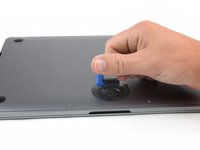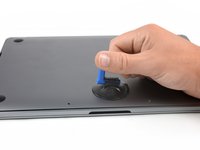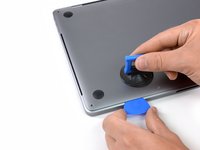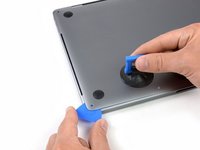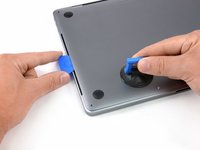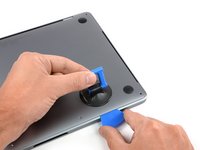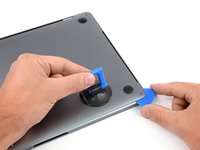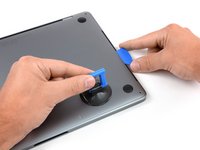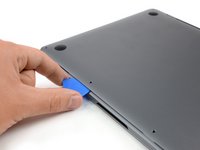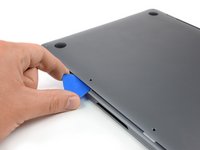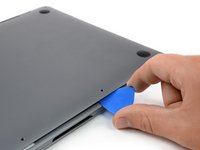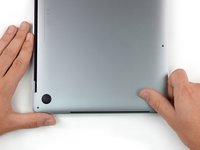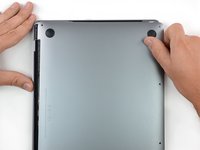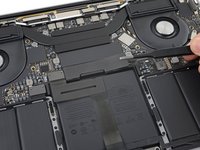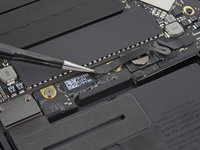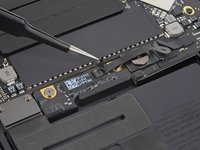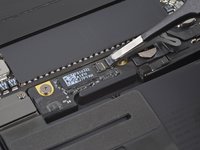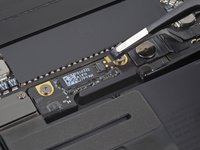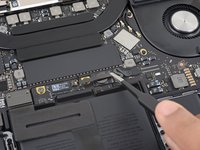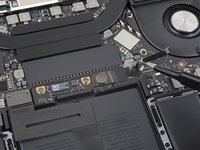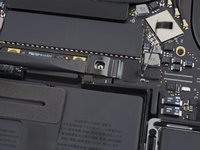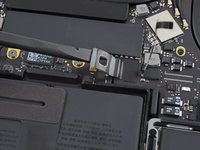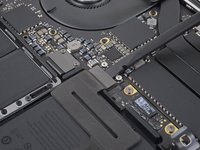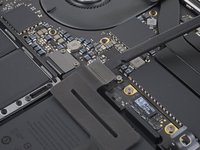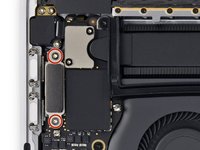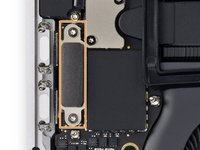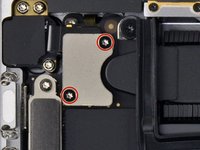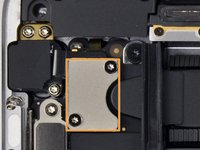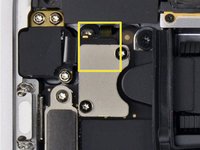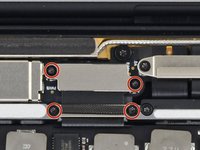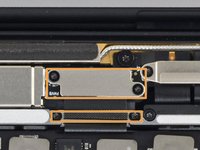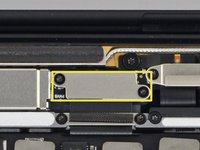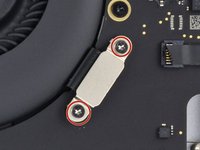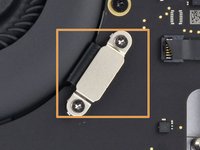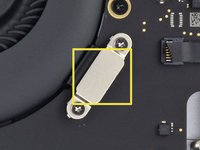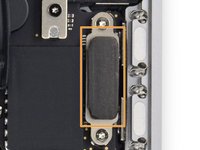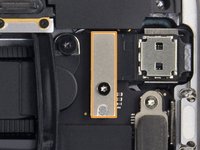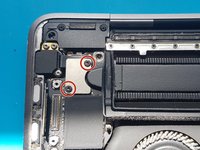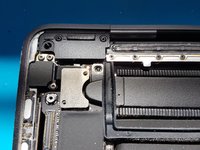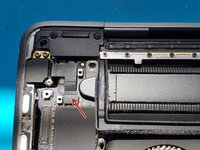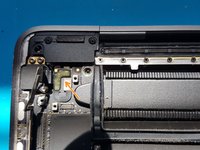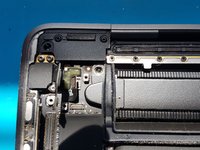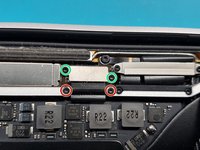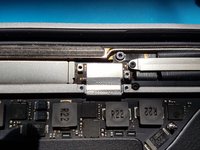Giriş
This guide will take you through the steps of replacing the heatsink in your 2018/2019 (A1989)MacBook Pro.
Neye ihtiyacın var
-
-
Power on your Mac and launch Terminal.
-
Copy and paste the following command (or type it exactly) into Terminal:
-
'sudo nvram AutoBoot=%00
-
Press [return]. If prompted, enter your administrator password and press [return] again. Note: Your return key may also be labeled ⏎ or "enter."
-
sudo nvram AutoBoot=%03
-
-
-
Use a P5 Pentalobe driver to remove the six screws securing the lower case:
-
Two 6.2 mm screws
-
Four 3.4 mm screws
-
-
-
Apply a suction handle to the lower case near the front-center area of the MacBook Pro.
-
Lift the suction handle to create a slight gap between the lower case and the chassis.
-
-
-
Insert one corner of an opening pick into the space between the lower case and the chassis.
-
Slide the opening pick around the nearest corner and halfway up the side of the case.
-
-
-
Insert your opening pick once again under the front edge of the lower case, near one of the two centermost screw holes.
-
Give the pick a firm twist to pop free the third clip securing the lower case to the chassis.
-
Repeat this procedure near the other of the two centermost screw holes, popping the fourth clip free.
-
-
-
Carefully peel up the large piece of tape covering the battery connector, on the edge of the logic board nearest the battery.
-
Remove the tape.
-
-
-
-
Use a spudger to gently lift the battery power connector, disconnecting the battery.
-
Lift the connector high enough so that it stays separated from its socket. If it accidentally makes contact during the course of your repair, it could damage your MacBook Pro.
-
-
-
Use a T3 Torx driver to remove the two 1.8 mm screws securing the trackpad cable connector bracket.
-
-
-
Use a T3 Torx driver to remove the two screws.
-
Two T3 Torx Screws.
-
-
-
Carefully peel back the black tape to reveal the ZIF connector.
-
Unlatch the ZIF connector by flicking the arm on the connector upwards and carefully remove the cable from the connector by sliding it out.
-
Repeat this process with the newly revealed connector.
-
-
-
Use a T3 Torx driver to remove the two screws.
-
Once the screw have been removed carefully remove the metal shield.
-
Under the metal shield there is a connector, carefully unplug it.
-
-
-
Use a T4 Torx driver to remove the two screws.
-
Two T4 Torx screws.
-
Carefully remove the metal shield.
-
The second cable you will disconnect will be lightly adhered so carefully slide a plastic spudger under it and finally unplug it.
-
-
-
Use a T3 Torx driver to remove the four screws.
-
4 T3 Torx screws.
-
Once the screws are removed carefully remove the metal shields.
-
Carefully unclip the connector.
-
-
-
Disconnect the cables carefully with a plastic pry tool.
-
-
-
Use a T3 Torx driver to remove the two screws.
-
Remove the metal shield carefully.
-
Carefully unplug the connector.
-
-
-
Carefully peel back the black tape to reveal the ZIF connector.
-
Unlatch the ZIF connector by flicking the arm on the connector upwards and carefully remove the cable from the connector by sliding it out.
-
Repeat this process with the newly revealed connector.
-
-
-
Carefully peel back the black tape to reveal the ZIF connector.
-
Unlatch the ZIF connector by flicking the arm on the connector upwards and carefully remove the cable from the connector by sliding it out.
-
-
-
Use a T3 Torx driver to remove the two screws.
-
Once the screw have been removed carefully remove the metal shield.
-
Under the metal shield there is a connector, carefully unplug it.
-
-
-
Use a T4 Torx driver to remove the screw.
-
T4 Torx screw.
-
Remove the metal shield carefully.
-
Carefully unplug the connector.
-
-
-
Use a T3 Torx driver to remove the two 1.4mm screws securing the bracket.
-
-
-
Use a T3 Torx driver to remove the two 2.4mm screws securing the display cable bracket.
-
Use a T3 Torx driver to remove the two 1.2mm screws securing the display cable bracket.
-
-
-
Use a T5 Torx driver to remove the four 3.2mm screws securing the two heatsink brackets.
-
To reassemble your device, follow these instructions in reverse order.
To reassemble your device, follow these instructions in reverse order.
İptal et: Bu kılavuzu tamamlamadım.
2 farklı kişi bu kılavuzu tamamladı.
3Kılavuz Yorumları
How much replacement thermal paste should be used on the CPU and heatsink?
I cleaned the old dried out thermal paste from the CPU and heatsink and replaced it with a rice grain sized amount of thermal paste, MX-4 on each die. After re-assembly, 2018 Macbook Pro 13" (A1989) works fine but has slightly higher temps and reaches max temps quicker (95C-100C), though idle temps seem lower (35 C). Web browsing is around 57C-60C. The fan also comes on sooner and stays on for longer.
I confirmed the screws holding the clips onto the board and heatsink are fully seated and not cross threaded. The exhaust air seems to be as hot as before, maybe a tiny bit less, so I don't think the heatsink is leaking. I didnt see any liquid on the motherboard.
Should I have used more thermal paste to cover the die AND the CPU package under the heat spreader like pictured in the last step (step 36)?
The only other thing I can think of is the fan duct gaskets are not properly seated and negatively affecting heatsink pressure on CPU dies.
I believe I solved this. I forgot to put the rubber gaskets on the heatsink near the fans. I tried to put them back in after the motherboard and heatsink was already installed. Trying to jam them in must have lifted the heatsink my <1mm causing poor contact.
I was seeing temps up to 100 C and sudden jumps in CPU temperature by 5 or more degree in under 5 seconds.
You can montor CPU temperature with the following command in terminal
sudo powermetrics --samplers smc | ts | grep -i "CPU die temperature"
Ctrl + C to exit
Removed the rubber gaskets for now. Temps dropped down to 50's C with minimal activity, mid 30s during idle and no longer seeing jump in CPU temperature when watching a youtube video. Peaks under full load around 83 C
Will re-install rubber gaskets properly at a later date.
sriag -
Rubber gaskets are pretty important. They form a seal between the bottom case and heatsink/fan. They force air to touch a section of the bottom case and then through the heatsink providing two methods of cooling. Without the rubber gaskets, the hot air circulates through the bottom case which gets hot and barely through the heatsink.
With the gaskets installed properly, temps stay lower longer, when fans are on it temperature drops faster and entire bottom case doesnt get as hot. Hot air is felt exhausting near the display hinges on the back.
Pro tip: install the heatsink rubber gasket seals on the heatsink after securing to the CPU and before reinstalling the motherboard into the case. Make sure they slot properly into the black channels when seating the motherboard into the top case.. while making sure the many cables dont get trapped beneath.
Good luck!
sriag -









